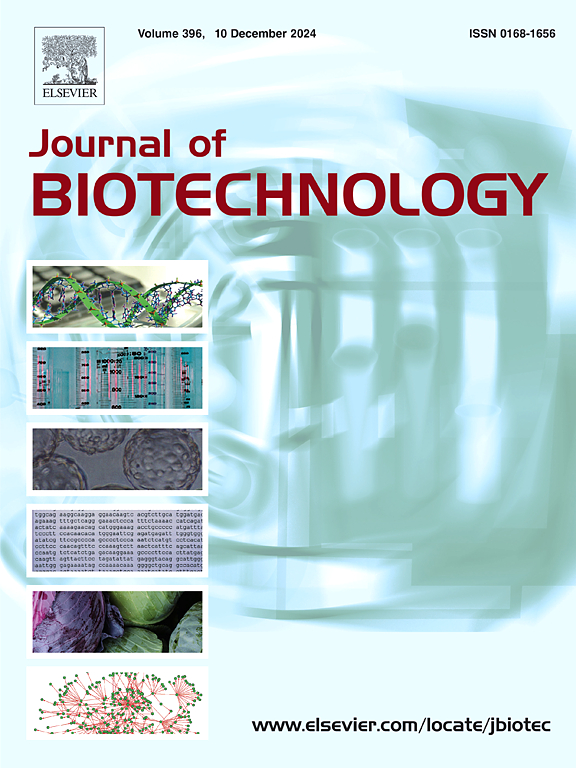微波辅助生物合成纯氧化铜纳米粒子的莴苣叶提取物:表征和抗菌活性评价。
IF 3.9
2区 生物学
Q2 BIOTECHNOLOGY & APPLIED MICROBIOLOGY
引用次数: 0
摘要
本研究描述了一种可持续和环境相容的途径,利用Lepidium sativum L.的叶提取物作为生物相容性还原剂,利用微波技术合成氧化铜纳米粒子(CuO-NPs),并评估了它们对肺炎克雷伯菌、铜绿假单胞菌、大肠杆菌和变形链球菌的抗菌活性和生物膜形成情况。采用能量色散x射线(EDX)、扫描电子显微镜(SEM)、x射线衍射(XRD)、红外(IR)和紫外可见(UV-Visible)、动态光散射(DLS)和x射线光电子能谱(XPS)对合成的CuO-NPs的大小、形状、晶体结构和稳定性进行了表征。合成的CuO-NPs在90天内表现出优异的稳定性。XRD证实合成的CuO-NPs为球形,平均粒径为30nm。此外,CuO-NPs对菌株表现出较强的抗菌活性,并能显著阻止生物膜的形成。本研究结果证实了一种有效、经济可行、环保的合成CuO-NPs的方法。结果显示它们具有显著的抗菌活性,表明它们可以作为标准抗菌疗法的潜在替代品,在成本和生物相容性方面具有主要优势。本文章由计算机程序翻译,如有差异,请以英文原文为准。
Microwave-assisted biogenic synthesis of pure copper oxide nanoparticles by Lepidium sativum L. leaves extract: Characterization and evaluation of antibacterial activity
This study delineates a sustainable and environmentally compatible route for the biogenic synthesis of copper oxide nanoparticles (CuO-NPs) utilizing the leaf extract of Lepidium sativum L. as a biocompatible reducing agent, employing microwave technology, alongside an evaluation of their antibacterial activity and biofilm formation against Klebsiella pneumoniae, Pseudomonas aeruginosa, Escherichia coli, and Streptococcus mutans. The size, shape, crystalline structure, and stability of the synthesized CuO-NPs were determined by energy dispersive X-ray (EDX), scanning electron microscopy (SEM), X-ray diffraction (XRD), infrared (IR) and ultraviolet-visible (UV-Visible), dynamic light scattering (DLS), and X-ray photoelectron spectroscopy (XPS). The stability of the synthesized CuO-NPs exhibited exceptional stability within 90 days. XRD confirmed that the synthesized CuO-NPs had a spherical morphology, with an average particle diameter of 30 nm. Furthermore, CuO-NPs displayed strong antibacterial activity against the bacterial strains, as well as significant prevention of biofilm formation. This study's findings confirmed the successful synthesis of an effective, economically viable, and eco-friendly synthesis method for CuO-NPs. The results reveal their substantial antibacterial activities, indicating their use as potential alternatives to standard antimicrobial therapies, with major advantages in terms of cost and biocompatibility.
求助全文
通过发布文献求助,成功后即可免费获取论文全文。
去求助
来源期刊

Journal of biotechnology
工程技术-生物工程与应用微生物
CiteScore
8.90
自引率
2.40%
发文量
190
审稿时长
45 days
期刊介绍:
The Journal of Biotechnology has an open access mirror journal, the Journal of Biotechnology: X, sharing the same aims and scope, editorial team, submission system and rigorous peer review.
The Journal provides a medium for the rapid publication of both full-length articles and short communications on novel and innovative aspects of biotechnology. The Journal will accept papers ranging from genetic or molecular biological positions to those covering biochemical, chemical or bioprocess engineering aspects as well as computer application of new software concepts, provided that in each case the material is directly relevant to biotechnological systems. Papers presenting information of a multidisciplinary nature that would not be suitable for publication in a journal devoted to a single discipline, are particularly welcome.
 求助内容:
求助内容: 应助结果提醒方式:
应助结果提醒方式:


